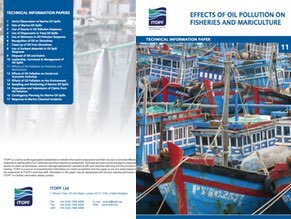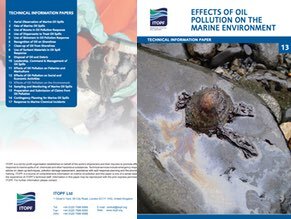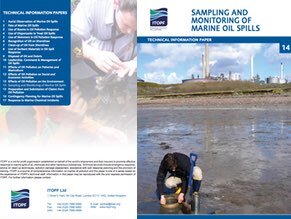Effects in Offshore and Coastal waters
Most oils float on the sea surface where they are spread over a wide area by currents, wind and waves.
Depending on the type of oil, it may disperse into the top few metres of the water column. As a result the potential environmental impacts of oil in open waters are generally confined to this upper area of the water column although, on occasion, some types of oil will sink and environmental impacts may be observed on the seabed. The types of organisms that are commonly impacted in an open sea spill include; plankton, fish, seabirds and marine mammals and reptiles.
Plankton
The upper pelagic zone of seas and oceans support a myriad of planktonic organisms, including bacteria, eggs and larvae, and a variety of animal and plant species. It is well established that plankton is sensitive to oil exposure and consequently short-term impacts should be expected in the immediate vicinity of the oil. However, organisms with planktonic life stages are characteristically present in the plankton in huge numbers and will naturally suffer very high levels of mortality. As a result, a large proportion of a given species will remain unaffected by the spill and it is rare for plankton mortalities following a spill to result in reduced adult populations.
Fish
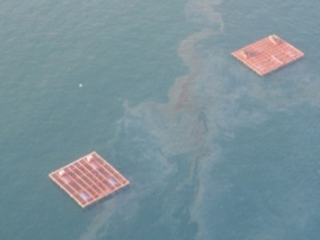
Although the eggs and larvae of fish may be susceptible to the effects of oil, adult fish tend to be more resilient. Reductions in wild fish stocks in offshore and coastal waters following oil spills have rarely been detected, as it is thought that fish can detect unfavourable water conditions and actively swim away to avoid them. Where mass mortalities have occurred, they have been caused by very high, localised concentrations of dispersed oil in shallow or confined waters. Fish mortalities can occur with cultured fish stocks where individuals are unable to actively avoid the oil.
Seabirds
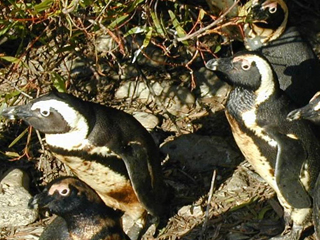
In open water, seabirds are some of the most vulnerable of all animals, and in some incidents large numbers may perish. Fouling of plumage (which is essential for thermoregulation and buoyancy control) is the most visible effect. Although cleaning and rehabilitation of birds may be attempted, success is often linked to the species of bird, and in many cases only a small fraction of those treated will survive. However, it is encouraging that with experience and research, best practices for bird cleaning are emerging and outcomes are improving. Increasingly, oil contingency plans define policies on how to deal with oiled seabirds and wildlife.
Sea Mammals and Reptiles
Due to the tendency of oil to float at the sea surface, marine mammals and reptiles are at risk as they must surface to breathe. The oil can potentially cause harm to nasal tissues and eyes and whilst mortalities caused by oil have been recorded, the majority of mortalities which coincide with oil spills have usually been found to result from other causes. Mammals that rely on fur to regulate body temperature can be vulnerable to the effects of oil as they may be harmed or die from hypothermia or overheating if their fur becomes matted with oil. For marine reptiles, the greatest impact is probably away from the open sea and on their nesting beaches should they become contaminated with oil.
11.어업 및 양식업에 대한 기름유출의 영향
이 문서는 선박기인 유류오염이 어업과 양식업에 미치는 영향에 대해 설명하고, 유류유출의 심각한 피해를 감소시키는데 도움이 될만한 대응 조치와 관리 전략에 관한 지침을 제공한다. 기타 경제적 자원에 대한 피해는 별도의 기술서에서 다루고 있다.
Categories: Environmental effects, Economic effects, Technical Information Paper (TIPS)
13.환경에 대한 기름유출의 영향
이 문서는 선박 기인 유류 오염과 방제작업의 결과가 해양 동식물과 그들의 서식지에 미치는 영향에 대해 설명한다. 특히 오랫동안 다양한 연구의 주제가 되어왔던 유류와 생태계 사이의 복잡한 상호작용에 관해 논의한다. 유류유출이 어업과 양식업, 광범위한 인간 활동에 미치는 구체적인 영향은 별도의 ITOPF 기술서에서 다룬다.
Categories: Environmental effects, Technical Information Paper (TIPS)
14.해상유출기름의 시료채취 및 모니터링 지침
이 문서는 유류 오염의 질적 및 양적 모니터링에 사용될 수 있는 시료 채취와 모니터링 절차에 관한 전체적인 개요를 제공한다. 질적 분석은 유류 오염의 출처를 확인할 수 있는 한편, 모니터링 프로그램은 시간이 지남에 따른 탄화수소의 양적 변화와 관계가 있다. 분석 우수사례에 대한 지침이 제공되고 일반적인 용어가 설명되어 있다. 그러나 특정 생태학적 또는 생물학적 영향을 추적 관찰하고 대기 중의 오염물질을 감시하는데 필요한 기술과 관찰은 여기서 다루지 않는다.
Categories: Environmental effects, Planning & operations, Technical Information Paper (TIPS)

